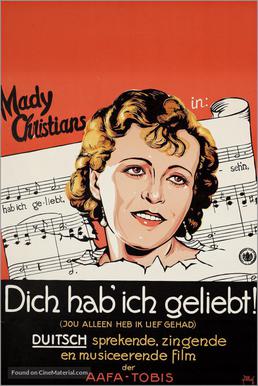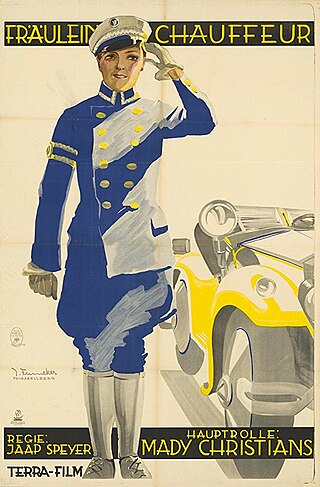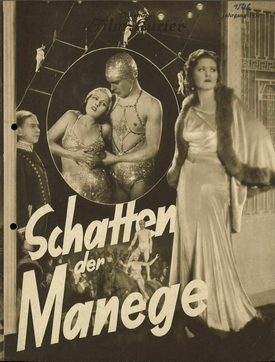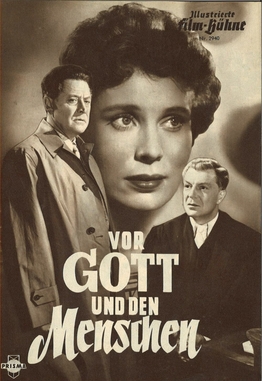Trude Berliner was a German actress. She was one of many Jewish actors and actresses who were forced to flee Europe when the Nazis came to power in 1933.

The Theft of the Mona Lisa is a 1931 German drama film directed by Géza von Bolváry and starring Trude von Molo, Willi Forst, and Gustaf Gründgens. It is based on a true story. It was shot at the Tempelhof Studios in Berlin. The film's sets were designed by the art directors Andrej Andrejew and Robert A. Dietrich.

Johannes Riemann was a German actor and film director. Riemann was a member of the Nazi Party.

It's You I Have Loved is a 1929 German drama film directed by Rudolf Walther-Fein and starring Mady Christians, Walter Jankuhn, and Hans Stüwe. It is considered the first full sound film to be made in Germany. When it was released in the United States, the film's plot was compared to that of The Jazz Singer. It is also known as Because I Loved You.

Three Days of Love is a 1931 German drama film directed by Heinz Hilpert and starring Hans Albers, Käthe Dorsch, and Trude Berliner. It was made and distributed by the independent Felsom Film company. It was shot at the Tempelhof Studios in Berlin. The film's sets were designed by the art director Hans Jacoby.

Miss Chauffeur is a 1928 German comedy film directed by Jaap Speyer and starring Mady Christians, Johannes Riemann, and Lotte Lorring. It was shot at the Terra Studios in Berlin. The film's sets were designed and part directed by the art director Hans Jacoby.

Tempo! Tempo! is a 1929 German silent adventure film directed by Max Obal and starring Luciano Albertini, Trude Berliner and Oreste Bilancia. It was shot at the Staaken Studios in Berlin and on location on the Italian Riviera. The film's art direction was by Botho Hoefer and Hans Minzloff.
Hunted Men is a German silent film made in 1924 and directed by Erich Schönfelder and starring Lucy Doraine, Johannes Riemann and Hans Albers.

Wrong Number, Miss is a 1932 German romantic comedy film directed by E. W. Emo and starring Magda Schneider, Johannes Riemann, and Trude Berliner. The film was shot at the Staaken Studios in Berlin with sets designed by the art directors Robert Neppach and Erwin Scharf. It was remade in Italian the same year as The Telephone Operator. In 1934 it was remade as a British film Give Her a Ring.

Marriage with Limited Liability is a 1931 Austrian-German comedy film directed by Franz Wenzler, and starring Charlotte Susa, Georg Alexander, and Paul Morgan. It was shot at the EFA Studios in Berlin. The film's art direction was by Otto Erdmann and Hans Sohnle. It was released by the German subsidiary of Universal Pictures.

Regine is a 1935 German drama film directed by Erich Waschneck and starring Luise Ullrich, Anton Walbrook and Olga Chekhova. It was shot at the Grunewald Studios in Berlin. The film's sets were designed by Otto Erdmann and Hans Sohnle.

A Thousand for One Night is a 1933 Czech-German comedy film directed by Max Mack and starring Claire Rommer, Trude Berliner and Harald Paulsen. A separate Czech-language version was also produced.

A Girl from the Reeperbahn is a 1930 Czech-German musical film directed by Karl Anton and starring Olga Chekhova, Trude Berliner, and Hans Adalbert Schlettow.

The Tiger Murder Case is a 1930 German mystery film directed by Johannes Meyer and starring Charlotte Susa, Harry Frank and Hertha von Walther. It was shot at the Babelsberg Studios in Berlin. The film's sets were designed by the art director Willi Herrmann.

Upstairs and Downstairs is a 1925 German silent film directed by Richard Oswald and Carl Wilhelm and starring Max Adalbert, Mary Kid and Valeska Stock.

The Gentleman from Maxim's is a 1933 German comedy film directed by Carl Boese and starring Lee Parry, Johannes Riemann and Oskar Karlweis. It was shot at the Johannisthal Studios in Berlin. The film's sets were designed by the art director Gustav A. Knauer and Walter Reimann.

The Rhineland Girl is a 1930 German musical romance film directed by Johannes Meyer and starring Gretel Berndt, Lucie Englisch and Werner Fuetterer.

Such a Greyhound is a 1931 German musical comedy film directed by Carl Heinz Wolff and starring Ralph Arthur Roberts, Max Adalbert, and Lucie Englisch. It was shot at the Babelsberg Studios in Berlin.

Circus Life is a 1931 German mystery drama film directed by Heinz Paul and starring Liane Haid, Oscar Marion and Trude Berliner. It was shot at the Babelsberg Studios in Berlin and at the Zirkus Busch in the city. It was released in America in 1932.

Before God and Man is a 1955 West German drama film directed by Erich Engel and starring Viktor de Kowa, Antje Weisgerber and Hans Söhnker. It was shot at the Tempelhof Studios in West Berlin. The film's sets were designed by the art directors Emil Hasler and Walter Kutz.


















